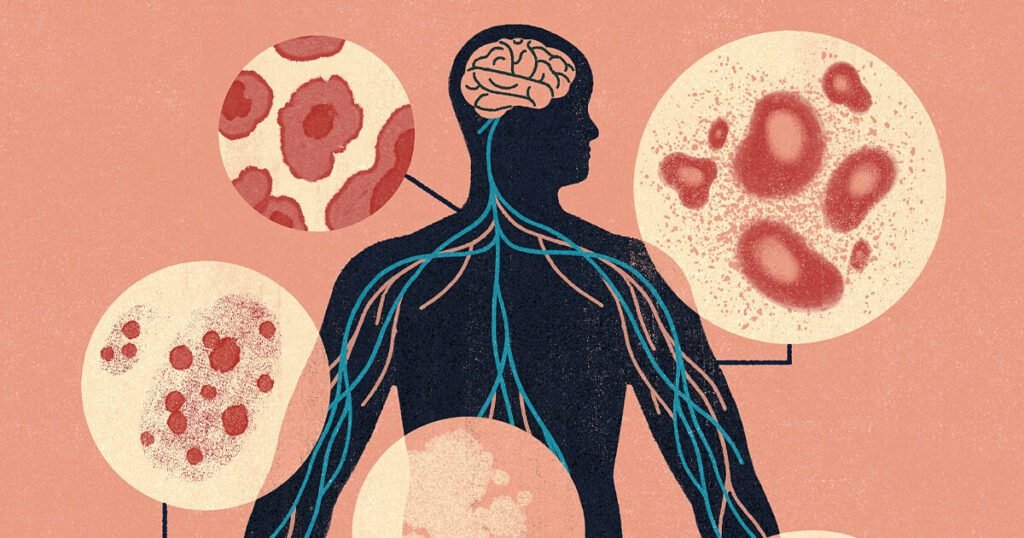Understanding the Connection Between Skin Conditions and Neurological Disorders
The Intriguing Link Between Skin and Nervous System Health
Recent findings have uncovered compelling correlations between certain skin conditions and neurological disorders like Parkinson’s disease. Conditions such as rosacea and seborrheic dermatitis may not only be skin-deep; they can serve as early indicators of underlying neurological issues.
Case Study: Rosacea as an Early Warning Sign
Howard Burnett, a financial adviser, experienced facial redness and bumps that were eventually diagnosed as rosacea—a common inflammatory skin condition among middle-aged adults. Initially dismissing his symptoms, Burnett sought medical advice due to worsening symptoms, eventually discovering he had Parkinson’s disease.
Key Points:
- Rosacea may precede other Parkinson’s symptoms like tremors.
- A 2020 study noted skin disorders can manifest years before other sickness symptoms appear.
Common Skin Conditions Linked to Neurological Disorders
-
Seborrheic Dermatitis:
- Affects oily areas and can present as scaly, inflamed skin.
- Though not everyone with this condition will develop Parkinson’s, it may indicate a higher risk in conjunction with other symptoms like sleep issues or constipation.
-
Bullous Pemphigoid:
- An autoimmune blistering disease prevalent among older populations.
- Linked to several neurological disorders, including Parkinson’s, dementia, and epilepsy.
- Melanoma:
- Studies show an increased melanoma risk in Parkinson’s patients.
- Existing research highlights that those diagnosed with melanoma have a heightened likelihood of developing Parkinson’s.
The Mechanisms Behind the Association
The skin and nervous systems share a developmental origin, originating from the same germ cell layer in the human embryo, known as the ectoderm. This shared origin explains why conditions affecting one system can influence the other.
Insights from Experts
Dr. Joseph Jankovic, a prominent neurologist, states, “The skin can be a window into the diagnosis of Parkinson’s disease.” This connection opens up opportunities for identifying biomarkers associated with various neurological conditions.
Conditions That Might Serve as Warning Signs
-
Birthmarks and Seizures:
- Children with freckling in unusual places may require neurological evaluation.
- Conditions like Tuberous Sclerosis Complex (TSC) can manifest through skin changes and lead to seizures.
- Skin Changes Post-Stroke:
- Examining skin irregularities like petechiae can offer insights into stroke causes.
- Conditions such as livedo reticularis could indicate underlying autoimmune disorders.
Managing Skin and Neurological Health
When it comes to treatment, managing skin conditions linked to neurological disorders can be straightforward but may involve a multifaceted approach:
- Topical Treatments: Antifungal creams for seborrheic dermatitis or steroid creams for bullous pemphigoid.
- Surgical Options: Removal of bothersome tumors and other dermatological interventions, especially in cases like neurofibromatosis.
Future Directions: Skin Biomarkers and Diagnosis
Research continues to explore skin-based biomarkers for Parkinson’s disease and other neurological disorders. Biopsies may become an essential tool for more precise diagnoses.
Important Findings:
- Accumulation of alpha-synuclein protein in the skin can serve as a distinguishing characteristic for Parkinson’s.
- Differences in skin protein accumulation may help differentiate Parkinson’s from conditions like Multiple System Atrophy and Progressive Supranuclear Palsy.
Conclusion: The Skin’s Role in Neurological Health
The emerging connections between skin conditions and neurological health highlight the importance of monitoring skin changes as potential markers for serious conditions. Awareness and appropriate medical consultation can lead to early detection and better patient outcomes.
For more information on Parkinson’s Disease, seborrheic dermatitis, and skin biopsies, consider visiting reputable health organizations or consult with healthcare professionals.
Relevant Resources:
Keeping a close watch on skin health could be key to understanding broader neurological health trends.


